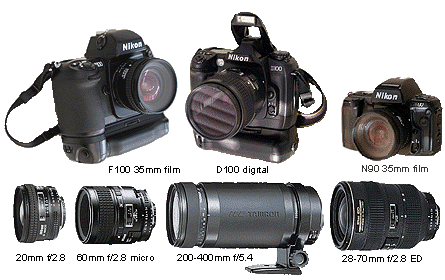 Nikon
SLR system Nikon
SLR system
What was wrong with my F100? After two years of brilliant service all over the world since 1999, it gave me nothing but muddy, incomplete exposures. The Swiss Alps, plus much of the nuptials of two good friends, were lost to film in 2002. (Thank God I did bring backups to the wedding: my old N90, as well as the Contax T2 and the Canon G1.) It happened after the batteries leaked at below-zero temperatures before dawn in Utah. Yet the mess was confined to the battery chamber within the vertical grip, which I did clean thoroughly afterwards. I was just about to sell the camera when, fondly giving its dials and switches one last go, I discovered the cause of my problem. The ISO setting was kept at 1600 for some fast films I was trying out. Had I reverted to the "DX" setting, the camera would have automatically recognized the ISO 200 and 400 films I was subsequently using. I then realized that I had made the same dumb mistake during my 12,000-mile tour of the American West in 1994, at the Arches National Park in Utah. The surest way to catch these mistakes before it's too late is instant exposure review on a LCD screen. With the D100, my journey to the digital side is complete. Imagine my distress when my $2K purchase broke down in only one month. Everything "digital" about it -- the video screen, memory card access -- failed while the auto focusing, metering and shutter release appeared intact. The good people at Samy's Camera in Los Angeles obligingly provided a replacement. The D100 is just as automated as the F100 (let's see if anyone makes a mechanical, manual-everything digital camera!), albeit with a slower shutter speed and frame advance. Contrary to its apparent designation, it is not built from the F100 at all, but a more affordable brethren, the N80 -- replete with the latter's softer poly-carbonate body (instead of magnesium alloy), focus-assist lamp and pop-up flash. The lamp can be a liability, since it would make you look like you're doing "flash photography" even when the actual flash is turned off. Because the D100's 6.1-megapixel charged capacitance device (CCD) sensor is only two-thirds the size of the exposure area for 35mm film, Nikon engineers concocted a 1.5x magnification within a more vertically-constrained field of view. This greatly reduces the coverage of wide-angle lenses, and slightly increases the power of the telephotos. While surveying landscapes or buildings, it thus makes sense to keep the low-distortion 20mm f/2.8 D on the camera most of the time. Small objects like local flora deserve the attention of the 60mm f/2.8 D Micro, which retains the subject's actual size (for 35mm film) and focuses at a nose's length away. For my calls to weddings and commercial shoots, the fast, versatile 28-70mm f/2.8 ED is the only lens I need. When a wildlife encounter is imminent, the Tamron 200-400mm f/5.4 telephoto is worth the extra burden. |
| MY CAMERAS TRAVELOGUE TITLE PAGE CONNECTIONS INDEX |
|
This web site is not affiliated with any of the companies cited herein, and is neither an official representation nor an endorsement of any of the said companies and their products. |